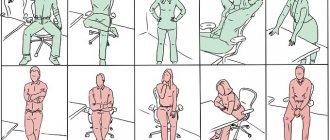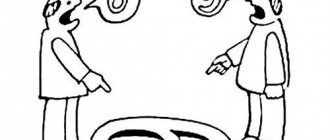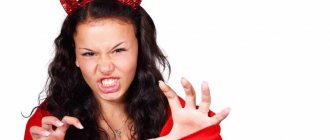The Rorschach test or Rorschach inkblot technique is one of the most famous psychodiagnostic personality tests. Each of us has seen at least one picture with blots that resemble... But here, in fact, the test begins, since the answer determines the individual properties and inclinations of a particular person. Recently, due to its massive distribution on social networks, the Rorschach test is often presented in significantly simplified versions, but in fact it is a powerful psychological tool. In this article, we tried to talk about it without confusing scientific terminology and, moreover, we wrote an online test based on the inkblot technique, the completion of which will allow you to determine the properties of your personality.
Rorschach test: what is it?
The Rorschach test is one of the most famous and popular projective drawing techniques, which was developed by the Swiss psychiatrist G. Rorschach. The first mention of this technique was in 1921. Then Rorschach published the book Psychodiagnostics.
The test consists of 10 cards (half color, half black and white) with symmetrical images created by ink blots. The psychologist shows the cards in a certain order and asks what it could be. The test taker must describe in detail what he sees in the image, where he sees it and why the spot causes such an association. The picture can be rotated, tilted or flipped. There is no time limit for taking the test.
There is an opinion that the image that a person sees indicates individual psychological characteristics and personality characteristics. Thus, according to the answers, it is possible to judge the psyche, understand the past and even partially predict future behavior.
It is important that the blots on the cards do not resemble anything in particular. This causes associative thinking. If you cannot describe the picture, this may mean the presence of certain psychological problems.
Answers are scored in 5 categories:
- Localization (the entire image or details are analyzed);
- Determinants (what attention is paid to: shape, color, etc.);
- Level of form (adequacy of reflection of the form of the image in the answer);
- Content (the answer concerns: people / animals / objects / fantastic images, etc.);
- Originality – popularity (the answer is rare or occurs in more than 30% of respondents).
Picture No. 2: two people
This drawing in the Rorschach test is most often perceived by test takers as sexual. And many people consider red elements to look like blood stains. Answers to this test can provide insight into the methods used to control pain, anger or feelings. Most people see these spots as a four-legged animal, a person looking at himself in the mirror, or two people.
- Two figures speak of an obsession with sex, an obsession with relationships.
- The dog symbolizes a faithful and devoted friend. If the test taker saw something negative in this card, then this may indicate the need to realize their own feelings or fears.
- A person looking at himself in the mirror speaks of narcissism or egocentrism of the person being tested. Depending on a person's feelings, this can be either a positive or negative trait.
- Elephant - symbolizes intelligence and memory, deep thinking, but it can also speak of negative physical self-perception.
- Bear - symbolizes aggression, independence, competition, but can also speak of vulnerability and insecurity.
- A person praying - this can symbolize attitudes towards sex from a religious point of view. Blood may mean that the person being tested associates physical pain with religion, as well as experiencing difficult emotions.
When and how is the test performed?
- Preparation. The psychologist explains basic information about the test and why it is being carried out.
- Carrying out the test. The specialist shows 10 pictures to the patient in turn. He must say what he sees in them. After this, everything is recorded in a journal and a conclusion is drawn.
- Survey . This is the final stage. The psychologist asks a few questions to the person, asking how accurate the associations with the picture are. This is necessary for better output.
In order to quickly and accurately draw a conclusion, the psychologist maintains a research protocol.
Picture No. 4: Carpet, leather, animal skin
This picture is called "father's". Most people see her as having a large figure (usually male). Responses to the perception of these spots reflect the attitude of the test taker to authority and the person’s upbringing. People also see the skin of an animal or a large animal (monster) in these spots.
- The skin of an animal symbolizes the discomfort associated with the theme of the father, but at the same time it may indicate that the person being tested does not have problems with inferiority and authority.
- A monster or large animal - symbolizes a feeling of fear, inferiority in front of the father, government officials or authorities.
Interpretation of results from cards
Card 1
This card features a black and white spot. Most often, patients see it as a bat, butterfly or moth. The card helps determine your personality type.
| Option | What is the stain associated with? | Feeling | Decoding |
| 1 | Bat | Trouble | Fear of the outside world and hidden intrapersonal problems |
| 2 | Butterfly | Positive | Ability to grow, change and overcome challenges |
| 3 | Mole | Devastation | Vulnerability and inability to cope with challenges |
| 4 | Butterfly | No | Loneliness and feeling of abandonment |
| 5 | Cat head | Uncertainty | Fear of the outside world |
Card 2
A black and red blot is depicted. Most of all associations with something sexual. Helps reflect a person's emotional state.
| Option | What is the stain associated with? | Decoding |
| 1 | People on the move | Having close relationships with others |
| 2 | Image of a person in the mirror | Egocentrism, narcissism, inability to take criticism |
| 3 | Dog | A man is a true friend |
| 4 | Elephant | Thoughts |
| 5 | The Bears | Hidden aggression and disobedience |
Card 3
A black and red spot is also depicted. And in this blot they most often see two people. This card helps to understand human social interaction.
| Option | What is the stain associated with? | Decoding |
| 1 | Two people having lunch | In society, a person is very active and can quickly adapt |
| 2 | Image of two dolls | The patient is removed from society. Also possible: poor emotionality, schizoid traits |
| 3 | Two people washing their hands | Paranoid fear and obsessive phobias |
| 4 | Man looking in the mirror | Egocentrism and inattention to others |
| 5 | People playing with each other | Inconsistency in your decisions, close social relationships |
Card 4
A black and white spot is drawn. The subjects more often mentioned associations with a large animal, a monster, or an animal’s hole. The interpretation of this card will allow you to learn about how a person relates to authorities and values.
| Option | What is the stain associated with? | Decoding |
| 1 | Big monster | Inferiority and worship of authority |
| 2 | Animal skin | Internal contradiction, intrapersonal conflicts |
| 3 | Fur or skin carpet | Fear of authority |
Card 5
There is a gray spot on the card. Most often, patients talk about a bat or a moth. This picture allows you to find out the personal traits of a person.
| Option | What is the stain associated with? | Decoding |
| 1 | Causes different associations than 1 picture | Previous cards caused a person great discomfort inside |
| 2 | Same associations as with 1 picture | Deep and personal problems |
Card 6
The picture shows gray. From this spot, the psychologist understands how close a person is to other people.
| Option | What is the stain associated with? | Decoding |
| 1 | Animal skin | Not wanting to interact with others |
| 2 | Nora | Mental emptiness and isolation from society |
| 3 | Fears and responses of a sexual nature | Hidden depression |
| 4 | Sexual intercourse | Fears of a sexual nature |
Card 7
A light gray spot that most people associate with women, children, and the feminine principle. The card helps determine your relationship with the female gender.
| Option | What is the stain associated with? | Decoding |
| 1 | Hard to tell | Difficult relationships with women. Women have a conflict with their mother |
| 2 | Head of a woman or children | Increased maternal instinct, need for care |
| 3 | Heads that want to kiss | The desire to be loved and have a relationship |
| 4 | Female genital organs | Difficulties in sexual life |
Card 8
Bright multi-colored blot. One of the most difficult pictures in the test. If it is difficult for a person to say what is depicted, it means that he has difficulty expressing his emotions.
| Option | What is the stain associated with? | Decoding |
| 1 | Hard to tell | The patient has a difficult life situation |
| 2 | Quadruped | Relaxation, emotional calm |
| 3 | Several images | Pettiness |
Card 9
Multicolor spots are also depicted. Decoding the association allows you to understand how the patient copes with the lack of certainty in any situations.
| Option | What is the stain associated with? | Decoding |
| 1 | Uncertain form of evil | Doesn't cope well with uncertainty. It's easy to piss him off |
| 2 | Human | Organized and good time management |
Card 10
This blot has the largest number of colors. Most often, people associate it with a spider, crab, snake, etc.
| Option | What is the stain associated with? | Decoding |
| 1 | Uncertain or negative feelings | Card 9 caused great difficulties for the person |
| 2 | Several images | Developed abstract thinking, integrity of human nature |
| 3 | Crabs and lobsters | Tendency to become attached to things, patience |
| 4 | Spiders | Involvement in a difficult situation |
| 5 | Caterpillar | Human growth and development |
Picture No. 1: bat, animal or moth
It is with these ink blots on a sheet of paper that the Rorschach test begins. Thanks to it, you can understand how the test taker perceives stressful and new tasks. Most often, people see the face of an animal, a moth or a bat in these spots. The answers to this picture give a general description of the person.
- The face of an animal indicates that a person knows how to react to problems, fear and reluctance to understand himself. This may also indicate that a person has a serious problem that he is avoiding and not solving.
- Mole - this suggests that the tester underestimates himself, his appearance, and can also symbolize weakness and irritation.
- A bat most often means something demonic, unclean, and for some it is the path through darkness to rebirth.
- Butterfly - if the person being tested sees a butterfly, then this symbolizes his ability to change, overcome obstacles, as well as a transition period.
Picture No. 9: man
The spots in this picture are colored and quite fuzzy; most people have difficulty understanding what they see. Therefore, the answers about these blots tell us about the test taker’s confidence and ability to cope with the shortcomings of the structure. Most people see a female figure or a person in these spots.
- The image of evil indicates that the person being tested needs order in life and does not tolerate uncertainty.
- Person – shows that the test taker knows how to cope with the unsystematic nature of time and information.









